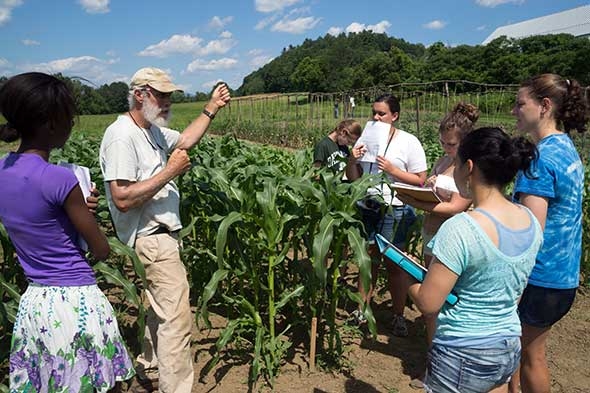Nearly two decades ago, Director of Sustainability Rosi Kerr ’97 caught her first glimpse of the Dartmouth Organic Farm.
“I was a rower, and the first time I saw it was from the water,” she says. “I thought, ‘Wow, that is such a beautiful spot. It seems like we’re not taking advantage of this place.’ ”

Scott Stokoe, second from left, manager of Dartmouth’s Organic Farm and adjunct instructor of environmental studies, discusses the effects of different growing conditions on corn with students in his “Ecological Agriculture” class. (Photo by Eli Burakian ’00)
That can’t be said anymore.
The 200-acre parcel of land, 3 miles north of campus, has been an operating farm for more than 150 years. With the help of the Sustainability Office and the Dean of the College, and renewed interest from students, the farm has become a valuable laboratory and classroom.
“This is a really unique slice of New England,” says Scott Stokoe, manager of the farm. Sporting a thick beard and a deep summer tan, he points toward the fields nestled next to the Connecticut River. “You have some of the region’s most productive soil right next to New England’s largest river.”
That said, Stokoe, an adjunct instructor of environmental studies, is quick to point out that the farm is focused less on production than on education, and it’s a place where students can experiment with the land. “Our students are our crop,” he says.
The farm, which Dartmouth purchased in the 1970s, hosts about a dozen or so field trips from Dartmouth classes each year, and Stokoe hopes more classes will use the land as a laboratory.
Sam Fey, a PhD student, uses the farm to conduct research. “The Dartmouth Organic Farm has been an invaluable resource during my five years as a graduate student,” says Fey, who studies how increases in temperature could affect certain species and ecosystems.
“There is nowhere else on campus that provides a safe and accessible area for students to conduct large-scale field research projects,” says Fey. “All of my dissertation chapters involved projects that I completed at the farm.”
The farm serves other purposes outside of the classroom. Students can also get ideas for growing fruits and vegetables and how to make compost, or they can try their hands tapping maple syrup from one of the numerous maple trees on the property. The farm has multiple greenhouses, a new timber-framed barn, vegetable fields, and water tanks for raising fish and studying sustainable food production.
“The farm was the first place I had ever grown a vegetable,” says Danielle Nathanson ’13. “It was a really new concept to me to be able to know the story of my food, and here was this great place where I could cook a meal and know exactly who had planted each of the vegetables I was cooking.” Nathanson wrote a creative non-fiction thesis on the history of the land.
Nick Reo, an assistant professor of environmental studies and Native American studies, uses the farm for his class “Encountering Forests.” He says the land is an amazing teaching resource.
“There are a variety of ecosystems and land uses moving from the river, through the floodplain and up into the wooded hills and ravines,” says Reo.
Kemi Mugo ’15 will undertake an independent study at the farm.
“I’ve been interested in agriculture and food policy for a while, and working at the farm provides me with a setting to talk and learn about important and interesting problems that we must confront very soon,” says Mugo.
A new zoning amendment passed by the Town of Hanover will allow for the site to be used more for educational purposes. Though Kerr has seen the farm transform greatly since she first spotted it from the Connecticut, she thinks it has even more potential.
“Ideally, it will be more than a farm,” says Kerr. “It will be a place to collaborate on solutions to problems.”